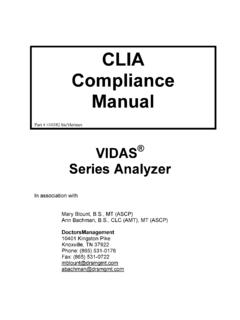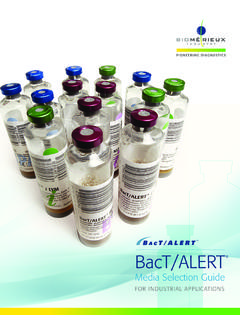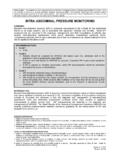Transcription of BLOOD CULTURE - bioMérieux
1 BLOOD CULTUREA key investigation fordiagnosis of bloodstream infectionsDr Susan M. D(ABMM), S(M)ASCPVice-President, Medical Affairs,Qvella, Carlsbad, CA, USAWm. Michael Dunne, D(ABMM), F(AAM, CCM, IDSA, PIDJ)Senior Fellow, Clinical Microbiology, Data Analytics Group,bioM rieux, Inc., Durham, NC, USAA djunct Professor of Pathology and Immunology,Washington University School of Medicine,St. Louis, MO, USAA djunct Professor of Pediatrics,Duke University School of Medicine,Durham, NC, USAfor their helpful advice and comprehensive review of this SPECIAL THANKS GO TOINTRODUCTIONThe laboratory detection of bacteremia and fungemia using BLOOD cultures is one of the most simple and commonly used investigations to establish the etiology of bloodstream infections.
2 Rapid, accurate identification of the bacteria or fungi causing bloodstream infections provides vital clinical information required to diagnose and treat is a complex inflammatory process that is largely under- recognized as a major cause of morbidity and mortality worldwide. There are an estimated 19 million cases worldwide each year,2 meaning that sepsis causes 1 death every 3-4 diagnosis and appropriate treatment make a critical difference when it comes to improving sepsis patient outcomes. Chances of survival go down drastically the longer initiation of treatment is delayed. If a patient receives antimicrobial therapy within the first hour of diagnosis, chances of survival are close to 80%; this is reduced by for every hour after.
3 Yet, if a patient initially receives inappropriate antimicrobial treatment, they are five times less likely to survive. 4 This booklet aims to: answer key questions commonly asked in relation to BLOOD CULTURE provide practical recommendations for routine BLOOD CULTURE procedures offer an illustrated step-by-step guide to best BLOOD CULTURE collection booklet is intended to be a useful reference tool for physicians, nurses, phlebotomists, laboratory personnel and all other healthcare professionals involved in the BLOOD CULTURE process..the laboratory detection of bacteremia and fungemia remains one of the most important functions of clinical microbiology A positive BLOOD CULTURE establishes or confirms that there is an infectious etiology of the patient s illness.
4 Moreover, it provides the etiologic agent and allows antibiotic susceptibility testing for optimization of therapy. 12 DEFINITIONSB acteremia: the presence of bacteria in the BLOOD . It may be transient, intermittent or continuous. BLOOD CULTURE : BLOOD specimen submitted for CULTURE of microorganisms. It enables the recovery of potential pathogens from patients suspected of having bacteremia or fungemia. BLOOD CULTURE series: a group of temporally related BLOOD cultures that are collected to determine whether a patient has bacteremia or CULTURE set: the combination of BLOOD CULTURE bottles (one aerobic and one anaerobic) into which a single BLOOD collection is Infection (BSI): an infection associated with bacteremia or fungemia.
5 Contaminant: a microorganism isolated from a BLOOD CULTURE that was introduced during specimen collection or processing and is not considered responsible for BSI ( , the isolates were not present in the patient s BLOOD when the BLOOD was sampled for CULTURE ).Contamination: presence of microorganisms in the bottle that entered during sampling but were not actually circulating in the patient s bloodstream. Fungemia: the presence of fungi in the : life-threatening organ dysfunction caused by a dysregulated host response to Septicemia: clinical syndrome characterized by fever, chills, malaise, tachycardia, etc.
6 When circulating bacteria multiply at a rate that exceeds removal by episode: an episode of sepsis or septic shock for which a BLOOD CULTURE or BLOOD CULTURE series is shock: a subset of sepsis in which underlying circulatory and cellular metabolism abnormalities are profound enough to substantially increase : Wayne, Principles and procedures for BLOOD Cultures; Approved Guideline, CLSI document M47-A. Clinical and Laboratory Standards Institute (CLSI); 2007 unless otherwise OF CONTENTS3 BLOOD CULTURE ESSENTIALS p. 2 1 What is a BLOOD CULTURE ? p. 4 2 Why are BLOOD cultures important? p.
7 4 3 When should a BLOOD CULTURE be performed? p. 5 4 What volume of BLOOD should be collected? p. 6 5 How many BLOOD CULTURE sets should be collected? p. 8 6 Which media to use? p. 10 7 Timing of BLOOD cultures p. 11 8 How to collect BLOOD cultures p. 12 9 How many days of incubation are recommended? p. 14 10 Is it a contaminant or a true pathogen? p. 15 SPECIAL TOPIC : INFECTIVE ENDOCARDITIS p. 18 PROCESSING POSITIVE BLOOD CULTURES p. 20 INTERPRETATION OF RESULTS p. 22 BLOOD CULTURE / SEPSIS GUIDELINES p. 24 REFERENCES p. 26 RECOMMENDATIONS FOR BLOOD CULTURE COLLECTION p. 301234541 What is a BLOOD CULTURE ?A BLOOD CULTURE is a laboratory test in which BLOOD , taken from the patient, is inoculated into bottles containing CULTURE media to determine whether infection-causing microorganisms (bacteria or fungi) are present in the patient s BLOOD cultures are intended to: Confirm the presence of microorganisms in the bloodstream Identify the microbial etiology of the bloodstream infection Help determine the source of infection ( , endocarditis) Provide an organism for susceptibility testing and optimization of antimicrobial therapy2 Why are BLOOD cultures important?
8 BLOOD CULTURE is the most widely used diagnostic tool for the detection of bacteremia and fungemia. It is the most important way to diagnose the etiology of bloodstream infections and sepsis and has major implications for the treatment of those positive BLOOD CULTURE either establishes or confirms that there is an infectious etiology for the patient s A positive BLOOD CULTURE also provides the etiologic agent for antimicrobial susceptibility testing, enabling optimization of antibiotic Sepsis is one of the most significant challenges in critical care, and early diagnosis is one of the most decisive factors in determining patient outcome.
9 Early identification of pathogens in the BLOOD can be a crucial step in assuring appropriate therapy, and beginning 3 MAIN AIMS OF BLOOD CULTURE *: Confirm infectious etiology Identify the etiological agent Guide antimicrobial therapy* Adapted from ESCMID (European Society of Clinical Microbiology and Infectious Diseases) guidelines, CULTURE ESSENTIALS13 When should a BLOOD CULTURE be performed? BLOOD cultures should always be requested when a bloodstream infection or sepsis is Clinical symptoms in a patient which may lead to a suspicion of a bloodstream infection are: undetermined fever ( 38 C) or hypothermia ( 36 C) shock, chills, rigors severe local infections (meningitis, endocarditis, pneumonia, pyelonephritis, intra- abdominal ).
10 Abnormally raised heart rate low or raised BLOOD pressure raised respiratory rateeffective antibiotic therapy as early as possible can have a significant impact on the outcome of the , 9v Providing adequate antibiotic therapy within the first 24-48 hours leads to:10-14 Decreased infection-related mortality (20-30%) Earlier recovery and shorter length of hospital stay Less risk of adverse effects Reduced risk of antimicrobial resistance Cost reduction (length of stay, therapy, diagnostic testing)0 Total patients (%)Time to antibioticsPatient survival rate (%)Patients with e ective antibiotic therapy200hours1234569122436406080100 Figure 1: Fast effective antimicrobial therapy increases survival chancesAdapted from Kumar A, et al.












